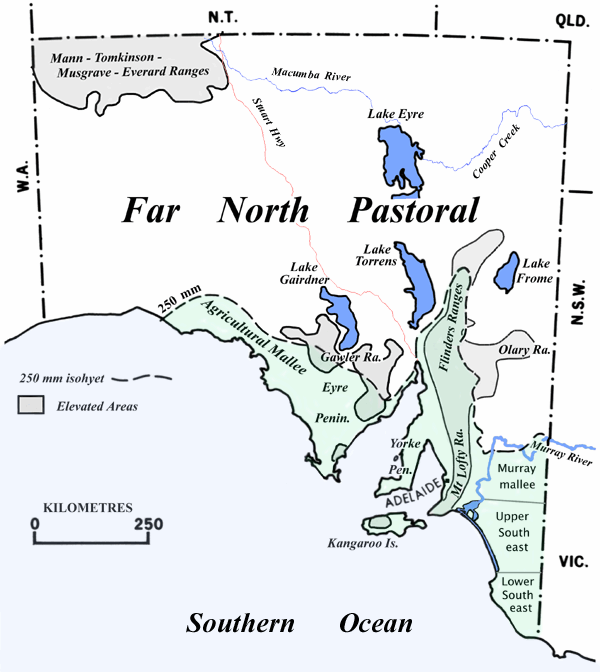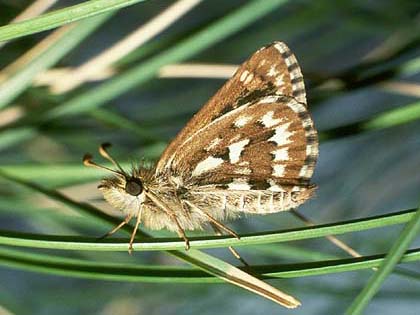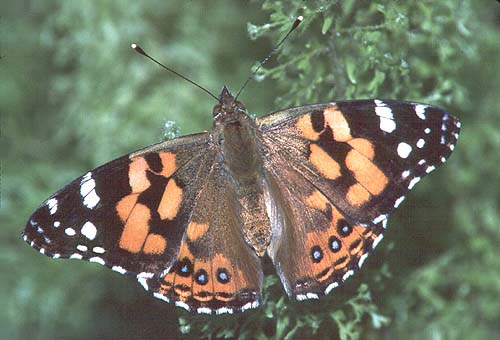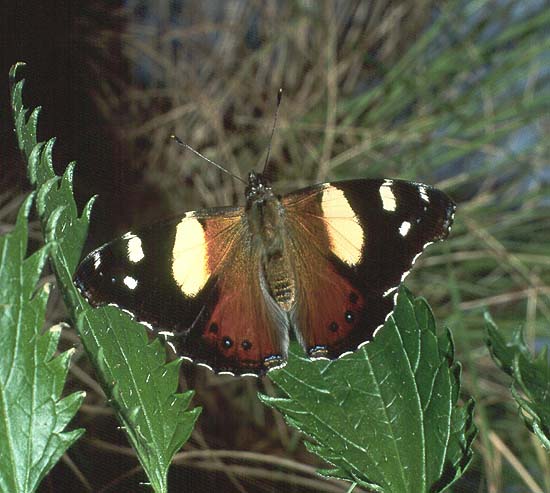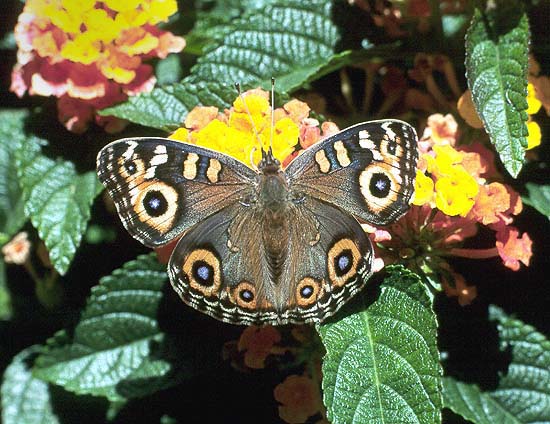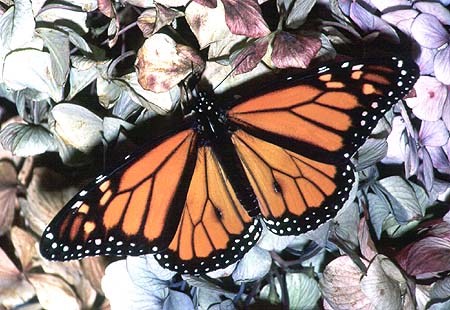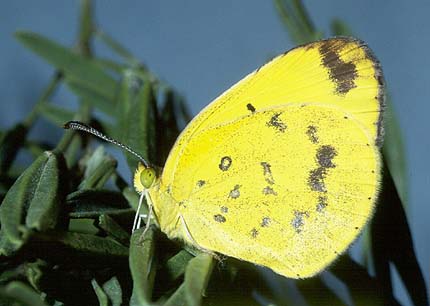-
Aridlands
-
The hot arid and semi-arid lands are located in the Far North Pastoral region and
comprise 80% of the state. It is a generally low area below 600 m and Lake Eyre
itself is below sea-level. Higher rocky areas occur in the Gawler, Olary and
northern Flinders Ranges (in southern areas), and the Mann, Musgrave and Tomkinson
Ranges in the far north-west. Vegetation is largely controlled by rainfall and soil
type. Habitats are extensive and monotonous. The vegetation is often very sparse,
particularly in the Lake Eyre Basin east of the Stuart Highway, consisting of very
open acacia or eucalyptus woodland, blue-bush and salt-bush shrubland, and grasslands.
Sometimes the vegetation is better developed along ephemeral waterways or within the
dune fields. The vegetation improves nearer the southern limits of the region where
extensive, open mallee (dryland Eucalyptus) and myall (Acacia papyrocarpa)
woodlands may occur.
Many of the migrant butterflies breed in this area after good rains, with 5
species of butterflies largely confined to the region. Some of the butterflies probably
lead a nomadic existence, moving along the ephemeral waterways. Butterfly populations
are believed to be mostly stable here, although the region has been poorly surveyed for
butterflies. The area suffers from the effects of overgrazing from feral (camels,
goats and rabbits) and domestic animals. In some areas there has been very little
self generation of woody flora since the coming of European settlement (1836), due to
the combined effects of periodic drought and overgrazing by the animals. Existing woody
flora in such areas are as old or older than this settlement! In this area also occur
the breeding grounds for the
plague locust. Control of the locust by the aerial application of poisonous sprays
has had a devastating effect on the local biodiversity, but hopefully new technology
through the use of a Metarhizium fungus may see a lasting improvement in the
environment.
The Everard, Mann, Musgrave and Tomkinson Ranges reach a maximum elevation of 1440 m.
The vegetation in these ranges consists mainly of the very prickly, tussocky spinifex
grass (Triodia sp), while the vegetation on the surrounding dune plains comprises
mulga (Acacia aneura) woodland infested with the pale-leaf mistletoe (Amyema
maidenii). Some of the valley areas contain spring water and better vegetation which
support resident populations of arid-land butterflies.
See what butterflies are in these areas:
Gawler Ranges,
Flinders and Olary Ranges,
Mann - Tomkinson - Musgrave - Everard Ranges.
-
Mallee Habitat
-
This habitat dominates the southern 20% of the state, and generally occurs in the
areas receiving rainfall greater than 250 mm. This vegetation type is dominated by
dryland Eucalyptus species but also contains many other smaller wood or shrub
land communities dominated by either Acacia, Banksia, she-oaks
(Allocasuarina), native pines (Callitris), or Melaleuca.
It is interspersed with occasional broadacre native grasslands. The understorey is
also complex and diverse, containing many butterfly foodplants including quandongs,
Choretrum, dryland sedges, grasses, and small shrubs and herbs.
Much of this mallee vegetation is tolerant of periodic bushfires, with the Eucalyptus
regenerating from lignotubers, while the Acacia and the understorey and other
associated vegetation are actually dependent on the bushfires for regeneration, with the
seed-base requiring the heat of the fire to weaken the hard outer seed capsule and the
smoke from the fire to impart certain chemicals for germination and enhanced early
growth. There is often a bushfire produced early growth cycle of certain flora
immediately after the fire that includes Leguminosae and Santalaceae, to a later mature
flora dominated by different plants than those present during the early part of the
cycle. There are certain butterflies which have adapted to these early immature and
late mature periods of the bushfire cycle.
-
Eucalyptus Forest and Open Wet Woodland
-
The forest and wet woodland habitats are confined to the higher rainfall areas of South
Australia. They occur in south-east Eyre Peninsula, western Kangaroo Island, the Mt Lofty
and southern Flinders Ranges, and in the Lower Southeast. They often have a diverse
understory of medium and small shrubs, herbs, sedges and grasses. Although small in area,
this habitat is home to a large range of butterflies. Two species are uniquely confined to
this habitat in the Mt Lofty Ranges.
See what butterflies are in these areas:
Southern Eyre Peninsula,
North Mt. Lofty,
South Mt. Lofty,
Lower Southeast,
Kangaroo Island.
-
Lower South-East
-
This is a cool and wet area, with annual rainfall greater than 700 mm. The vegetation is
unique, comprising forest, wet woodland and swamps with close affinities to the Grampians
and Great Dividing Range in Victoria. This habitat area also contains a unique butterfly
fauna with eleven of the species present not to be found anywhere else in South Australia.
More unique species are likely to be found in the future, although some species are also
now probably extinct as a result of the extensive clearing and swamp drainage that has
occurred in the region.
-
Wetlands
-
Wetlands are an important habitat of low lying areas, associated with creeks, rivers,
lakes and estuaries. Springs are also a very important contributor to wetlands.
Sedges (Cyperaceae family), and in particular the large saw-sedge Gahnia
species are an important vegetation component of wetlands. Some wetlands are
dominated by sedges, and are called sedge-lands. Sedges are the dominant foodplant
for the Hesperillini skippers and several brown butterflies.
Due to the severe degradation of our wetlands by fragmentation and draining,
nearly all of the butterflies dependent upon wetlands for habitat or foodplant are
now threatened.
-
Grasslands
-
Native grasslands occur locally throughout the state. In the dry pastoral and mallee
areas they occur as Austrostipa (spear-grass), Astrebla (mitchell grass),
and Triodia (spinifex) dominated grasslands. In the wetter forest and marsh areas
Poa tussock-grasses sometimes dominate the understorey. Grasslands can occur in
broadacre form but more often contain isolated trees and shrubs, and occur with rushes,
sedges, and small herbs. Many species of butterflies associate with grasslands, with
certain skippers and brown satyrid butterflies being totally dependent on this habitat.
Native grasslands have historically been severely degraded by over-grazing and stock
trampling, and consequently many of the associated butterflies are threatened, including
the White-veined Grass-skipper and the Cynone Grass-skipper.
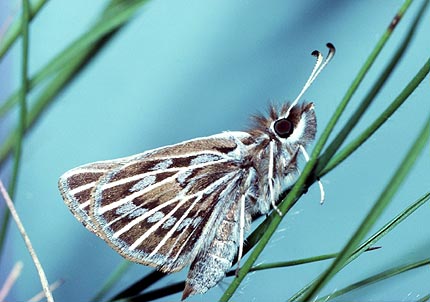
White-veined Grass-skipper
-
Coastal
-
This is a very narrow zone adjacent to the sea, varying from high cliffs to sand dunes
and estuarine ecosystems. There is a wide range of very specific vegetation types
and habitats, including estuarine mangroves, sedge wetlands and samphire marshes,
shrubland and mallee in the dunes, and low coastal heaths along the cliffs. It is
often a harsh habitat due to the salt laden winds, but many butterflies thrive in the
environment.
-
Urban
-
The urban region is the habitat of common butterflies, and is also briefly frequented
by migrating butterflies. Flowering garden plants are the resting and re-fuelling
stations for butterflies as flowers contain nectar, the main food source for the adults.
Buddleias, lantanas and many other plants can attract butterflies to the garden.
There are about 20 species of butterflies which are commonly seen in gardens
in the southern parts of the state, and include the Australian Painted Lady,
the Australian Admiral, the Meadow Argus, the Monarch and various migrant butterflies
such as the Caper White and the Small Grass-yellow.
-
Migrant and Vagrant Butterflies
-
These species either periodically or annually migrate in numbers (migrants), or singly
(vagrants) within South Australia, over short or long distances. Many butterfly species
have this tendency (especially the females in the case of vagrants), and particularly
during favourable seasons, as it is mostly used as a means of dispersal in Australia.
This habit is particularly strong in the white, yellow and nymph butterflies. These
butterflies are common near their food plants in their normal breeding habitat, which
is usually either in the northern pastoral areas of the state, or interstate. Many of
the species from the latter two areas are biologically unsuited to the southern parts of
the state and do not establish even if the food plant is present.
There are about 30 butterflies presently recorded from South Australia
that have migration tendencies.
